
Today, if your personal or professional interests require any sort of public presence, social media is a must. In this brave new world of low-friction and no-barrier-to-entry broadcast capabilities, social media is where brands live… and sometimes die. Well, maybe not die, but take a serious beating.
While brands rebound and the public is known to possess a remarkably short memory, such social media blunders can harm any company’s reputation, jeopardize important deals/partnerships, and generate a plethora of online content negatively – and permanently – associated with your name.
To understand how damage from social media blunders can be lasting, even if not lethal, consider Chick-fil-A. If you’re not familiar, a quick consultation with Professor Google should shift the point clearly into focus.
I want to share some of the more memorable instances of those Twitter takedowns and Reddit wreckings, with a mind to learn from and prevent any such buffoonery. As part of the effort to turn these terribles into teachables, I’ve broken each of our blunders into 6 categories to help guide your social media activities.
Many of the examples listed may just as well belong to two or three of the different categories I’ve created. I’ve tried to sort them to most sharply reflect the lessons they serve to teach. If you have an alternative arrangement that you think more appropriate please share it in the comments.
Class Matters
This is the first principle of good social media marketing that I’m laying down. It’s first because it’s not always so obvious. Being edgy is good and being risqué can often provoke a viral response.
That being said, there is a line that separates risqué posts from classless posts. In their zealousness to grab attention and stand out from a crowded pack, social media marketers often cross that line to disastrous effect.
Number 10:
My favorite example of falling for this trap comes from Chad Shanks, the former manager of the Houston Rockets’ Twitter account. Former, past tense.
The Rockets were pitted against the Dallas Mavericks in the first round of the NBA’s 2015 Playoffs. Near the end of game 5, with their fourth win in a best-of-seven series in tow, the Rockets had all but guaranteed their place in the Conference Semi-Finals.
That’s when Chad chimed in with this tweet:
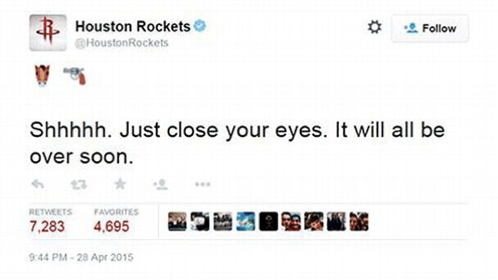
Now, I don’t mind admitting that I actually find this tweet pretty funny, but the fact of the matter - as was quickly pointed out by the Mavericks and echoed by the Twitterverse – is that it’s downright classless.
Class matters, kids! Chad was fired and the Rockets had a bit of a PR debacle to deal with. Funny is good and dark can sometimes lend itself to substantive social commentary, but always err on the side of class.
Chad’s poor judgment cast the entire organization in a bad light precisely when managing public relations, on the internet or elsewhere, should has been extremely easy and straightforward.
Dishonorable Mentions:
That time Conservative political commentator Ann Coulter took to Twitter to express dissatisfaction with the perceived pandering of GOP Presidential candidates to special interests? Nothing wrong with that, right?
Well, the way she went about it was – let’s say – highly questionable. “How many f---ing Jews do these people think there are in the United States?” Umm, what?
Given her track-record, it’s fair to say that Ann’s tweet was not an expression of anti-Semitism, but classless belligerence. Still, it’s hard to forget such an epically tragic ploy for attention.
Also not to be forgotten is when Dave & Buster’s took to Twitter to do its best impression of your simultaneously cheesy and racist uncle. Ladies and gentlemen, if you’re unsure of that voice in your head telling you good taste from bad taste, avoid edgy. Hell, avoid social media.
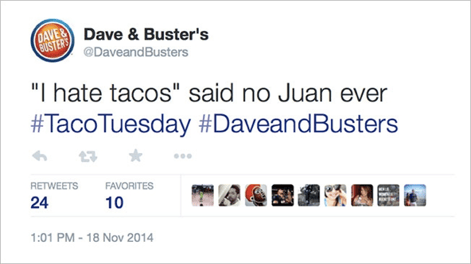
Think Like the Haters
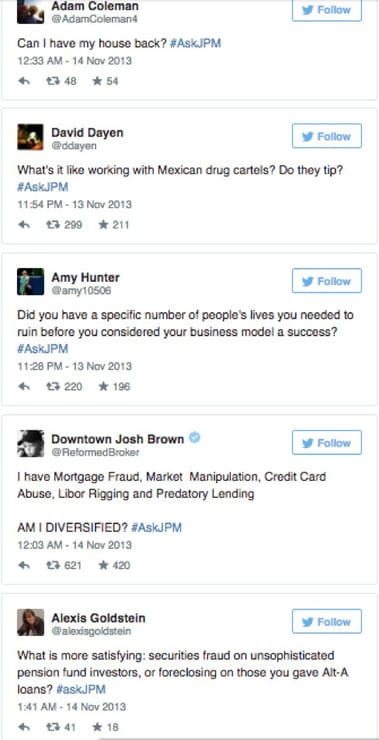
There’s a reason why people are still reading The Art of War some 2,500 years after it was written. That’s because it contains some really amazing strategic observations, insights, and considerations. One of Sun Tzu’s keenest insights comes in his proclamation that “to know your Enemy, you must become your Enemy.”
As weird as it may seem, the same is true of social media. One of the biggest social media blunders any marketer can make is to forget that the internet is swarming with trolls and haters who would love nothing more than to make a fool of you.
Before you post anything, ask yourself how it will play with your haters. Take the message and try to turn it against your organization. If you succeed, scrap the message and start over.
Number 9:
Part of this being your enemy/thinking like the haters mantra is knowing which way the wind blows.
In 2013, if you’re a hulking global financial institution with a long history of reckless subprime lending, bad-debt bundle-trading, and systemic market manipulation, you should be keeping a low profile on social media. In fact, your presence should be entirely limited to coverage of charitable donations and internal reforms.
Sadly, it would seem that JP Morgan never got that memo. All the same, the internet masses were kind enough to inform them. In the end, it took the company five days to get the message. Five days and a big headache
In November of 2013, @jpmorgan announced that it would be hosting a live Twitter Q&A with company vice chairman Jimmy by tweeting, “What career advice would you ask a leading exec at a global firm? Tweet a Q using #AskJPM. On 11/14 a $JPMleader takes over @JPMorgan.”
Now, to be fair, it’s a fairly benign tweet. The problem is all in the subtext. When people are literally calling for your head, you don’t carry on as if you’re a scion and God’s gift to the world. You assume a public posture of humility and earnestness and you generally shut up.
Number 8:
Another great example of someone too caught up being herself to even consider the haters is E.L. James, author of 50 Shades of Grey. Now, by any measure James is a successful individual. Such success can sometimes make it hard to remember that not everyone is ready to sit down and join in celebration of your accomplishments.
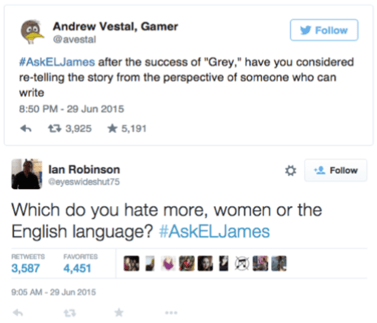 Any author worth his or her salt is prepared to face the fact that everyone’s a critic. Certainly, E.L. James has taken her share of lumps on her way to fame and acclaim. That being said, there’s a big difference between a critic and a heckler. In print media, everyone’s a critic; in digital media, everyone’s a heckler.
Any author worth his or her salt is prepared to face the fact that everyone’s a critic. Certainly, E.L. James has taken her share of lumps on her way to fame and acclaim. That being said, there’s a big difference between a critic and a heckler. In print media, everyone’s a critic; in digital media, everyone’s a heckler.
So it was when James, in her innocence, (ironic much?) announced that she’d be hosting an Ask Me Anything session on Reddit that the the vultures began to circle.
Add to this ill-fated setup the fact that James’ book is controversial - not least for its graphic sexual content, but for the unilaterally domineering, almost violent nature of the relationship it depicts – and the fallout that ensued appears inevitable.
To defeat the hater, you’ll need to think like the haters. No matter who you are and how much fanfare you’re insulated with, never forget that you have haters galore. It’s ugly, but it’s true.
Dishonorable Mentions:
That time in 2014 that the NYPD was stupid enough to give its critics a platform to publicize instances of police misconduct. The department asked people to tweet their photos with New York police officers, using the hashtag #myNYPD. Needless to say, the images that flooded the Twitterverse depicted New York's finest in an aggressive and unflattering light.
Again, if you’re dealing with PR issues, I shouldn’t have to tell you that you need to pick your words and your marketing campaigns extremely carefully.
Context Matters
 Remember that recurring nightmare you had? You’re at school, in the middle of giving a presentation in front of the class, when all of a sudden you realize that you’re buck naked. The sheer horror was enough to wake you from even the deepest sleep.
Remember that recurring nightmare you had? You’re at school, in the middle of giving a presentation in front of the class, when all of a sudden you realize that you’re buck naked. The sheer horror was enough to wake you from even the deepest sleep.
But why? It’s not like you’re afraid of your body. It’s not like you’re a Never Nude. You’re not horrified because you’re naked, you’re horrified because of the context. And that’s the point. Context is a very powerful thing.
What’s A-OK in one context can be a terrible embarrassment in another. This is something that all marketers need to keep in mind, but is of outsized significance in the world of social media marketing.
Since the speed of consumption is so much slower with traditional media, it’s a problem that can be caught and corrected even at later stages in the production cycle. On social media however, if an innocent contextual mistake slips past your editors and makes it live, it is forever. No matter how quickly you manage to identify and correct the mistake, it will live to haunt you.
Number 7:
So it was in 2012, when Chinese-American NBA guard Jeremy Lin surprised the world with his rapid ascent from street free agent to pro Phenom, that a writer at ESPN wrote an incredibly boneheaded story headline – “Chink in The Armor”.
Maybe I’m naïve, but I feel confident that the title choice really was an innocent mistake. Still, it cost one Anthony Federico his job and ESPN a considerable amount of grief.
Would this title have elicited a word of criticism if it were written about say Carmelo Anthony? Of course not! Why? Context.
Number 6:
Another favorite example, highlighting the power of context in marketing, goes back to 2014, when LG tried to seize upon Apple’s troubles with “Bendgate” to promote their own smartphones.
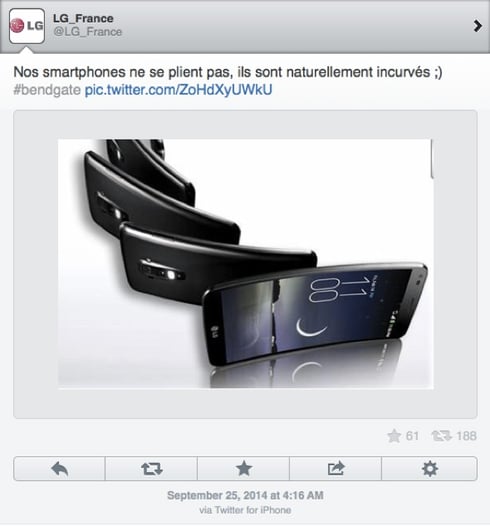
Nothing remarkable in a company setting its crosshairs on a rival, except in this case, the tweet intended to mock Apple was sent from an iPhone. Truly, it’s for reasons like these that the term facepalm was invented.
Personally, I am grateful to LG for expressing my point about context with such comedic eloquence. Bravo!
Number 5:
Remember when I wrote that many of these examples rightly belong to more than one of the lesson categories I created. Well here’s a prime example.
What do context and class have in common? Neither of them were borne in mind when an employee at London’s Luton Airport posted to Facebook an image of a South West Airlines plane that slid, from a icy runway into nearby traffic. The caption accompanying the post? “Because we are such a super airport....this is what we prevent you from when it snows......Weeeee :)”
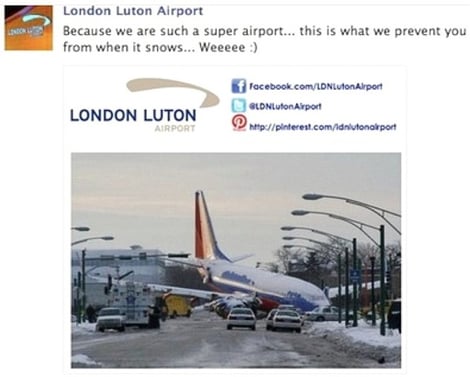
Extremely unprofessional, sure, but what’s worse is that a six-year-old boy died in the accident. Missing context, class, or research – I don’t much care – this sort of thing is simply inexcusable.
It should come as little surprise that the internet had comments aplenty for London Luton Airport. And rightfully so. From a human perspective, this is probably the biggest screw-up on the list.
Dishonorable Mentions:
That time the guy managing Chrysler’s Twitter account thought he was signed in to his personal account and proceeded to insult Detroit motorists, in broad and expletive filled language. Naturally, Chrysler fired the schlub. Sure, it’s nowhere near the most embarrassing thing on this list, but it did manage to make Chrysler look stupid and unprofessional all at the same time.
Do Your Research
I don’t think I really need to explain why it’s important to do your research before publically endorsing and broadcasting a message. But in case I’m wrong, let the following examples be explanation enough.
Number 4:
 Is it wrong to launch a marketing campaign - or brand for that matter - designed to appeal to our common patriotism? It may be a bit cynical to try to commercialize such a deep and abiding sense of love and loyalty, but by most standards it’s fair play. On the other hand, if you’re trying to seize on national pride and pomp and you instead invoke a famous national tragedy, that is wrong.
Is it wrong to launch a marketing campaign - or brand for that matter - designed to appeal to our common patriotism? It may be a bit cynical to try to commercialize such a deep and abiding sense of love and loyalty, but by most standards it’s fair play. On the other hand, if you’re trying to seize on national pride and pomp and you instead invoke a famous national tragedy, that is wrong.
Yet, that’s exactly what the brilliant minds at American Apparel did when, in celebration of July 4th, they posted a stylized picture of the Challenger space shuttle explosion to their Tumblr account. Making them seem even more clueless, (sadistic?) they accompanied the image with the hashtags “#smoke” and “#clouds.” Way to go, guys! You sure nailed that bit of Americana.
If you’re managing a brand’s social media channel, please do your research before making use of any images, quotes, hashtags etcetera. Please!
Number 3:
This next one truly confuses me. I really can’t understand how this could have been an innocent mistake. At the same time, I can’t understand how someone can do this deliberately and actually think that it wouldn’t backfire.
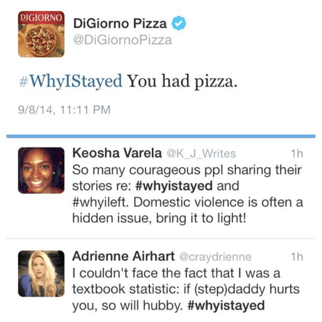
So what exactly am I going on about? Well, in September of 2014, DiGiorno Pizza sent out the tweet pictured to the right. Now, you’ll notice that this hashtag is used in a very specific context. Namely, for victims of domestic violence to share their stories of abuse and survival.
If the author of the tweet didn’t understand the meaning of the hashtag, the tweet makes no sense at all. Then again, if he or she did, it’s possibly the worst joke ever. I guess we’ll just have to file this away as one of life’s enduring mysteries.
I’m listing it here under “Do Your Research” instead of “Class Matters” because - being the nice blogger that I am - I’ll assume that the social media team responsible for this was composed of complete idiots rather than plain old scumbags.
Either way, the lesson is the same – Google is your friend. Do your research and use your brains!
Dishonorable Mentions:
That time a staffer on Donald Trump’s campaign team mistook Nazi for American soldiers and featured them prominently in a patriotic digital poster.
Also not to be forgotten, is when Delta tried and epically failed to newsjack the World Cup. In reference to a game between the US and Ghana in which the US triumphed, two goals to one, Delta tweeted to congratulate team USA. Along with the congratulatory message was a picture of the Statue of Liberty as a symbol for the US and a picture of a giraffe as symbol for Ghana.
The thing is, giraffes aren’t indigenous to Ghana. Cultural ignorance is bad enough but when vast assumptions are made about a nation based on stereotypes of an entire continent, you’re asking for trouble.
Triple Check Everything Before Posting
When Alexander Pope used the phrase “To err is human” he wasn’t kidding. We all make mistakes and that’s okay. But there’s no reason why the whole world needs to see your mistakes. To prevent that, it’s important to rely on editors. A content producer – whether focusing on social media messaging, blogs, or both – without an editor is like a ship without a rudder.
Despite the oversight of an editor, errors are still liable to slip through. What can be easily corrected one second will be forever cached the next. That’s why it’s so important to triple check everything before posting. This goes for the writer as well as the editor.
Triple checking is a super simple procedure to implement but is often neglected due to its sheer tedium. Don’t skip over or auto-pilot through this important control. More often than not, it will catch mistakes. Sometimes it will even save you huge embarrassment.
Number 2:
If you ask me, the most poignant example of a social media misadventure stemming from lack of editorial review comes from the New England Patriots, of the NFL. As the team’s Twitter account closed in on one million followers in 2014, someone in the organization had the bright idea to use that milestone to launch a marketing campaign.
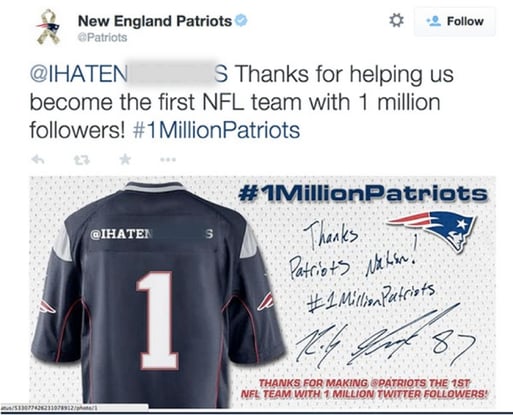
I’m not being sarcastic; it really was a bright idea. The team promised to give away a free jersey to its one-millionth follower, customized with his or her Twitter handle written across the back. Naturally, hordes would follow the @Patriots handle in hopes of being lucky number one million.
The problem wasn’t in the concept but its execution. It seems that the Patriots automated their social media to such an extent that the post was generated either without any human involvement or without the involvement of any human with an adult’s IQ.
As it just so happened, the one-millionth follower had a grotesquely racist Twitter handle. Yet somehow that did not stop the tweet shown below from going out. Anyone with half a brain who comes across this tweet would know that it’s not suitable for publication.
Here’s the takeaway: If a post can make it to publication without even once being seen beforehand by a person with half a brain, you have a structural problem in your approach to social media.
Dishonorable Mentions:
Seriously, US Airways? Shame on you. I won’t even discuss this.
Be Real or Be Gone
When we get down to it, the most fundamental social media blunder is being insincere. Traditional media are expected – by and large - to be insincere. They’re controlled channels at the disposal of the highest bidder.

The whole idea of social media is that it allows people to INTERACT in a more casual and convenient way. No one is confined to the role of listener and no one has a monopoly over the broadcast. It’s not a commercial, it’s a conversation. (In this sense, social media mirrors the supersession of Inbound over Outbound marketing and echoes its philosophy.)
As such, you gotta keep it real. I’d go so far as to say that if you’re not keeping it real, you really aren’t doing social media – you’re just doing traditional media through social channels. Social media needs to be inherently engaging.
Success is measured by viral effect, not the number of your distribution channels. And the things that consistently do go viral are those that manage to engage real people in ways previously unseen.
If you’re paying attention, you should understand that for brands, this means their social media marketing should be characterized less by pomp and promotion, and more by direct, sincere dialogue. Many brands understand this and primarily use their social channels to field customer inquiries and attempt to satisfactorily resolve any grievances.
Sadly, there are still some out there who don’t get it and insist on carrying on with their old-fashioned control-the-narrative marketing techniques. Essentially, this is a failure to properly understand and adjust to context, but since it’s such a fundamental misstep in the age of digital marketing, I’ve created a category unto itself for this type of blunder.
Number 1:
It makes sense that when you have a question about a product you’d ask those behind the product for an answer, right? You would think, but apparently not if the product is Smuckers jam. Last year, Smuckers was caught deleting questions and comments from it’s Facebook page. Why? Because the comments were negative or included questions that the company didn’t want to answer.
This wouldn’t be a big deal if the comments were lewd or inappropriate but they were neither. They were just inconvenient. It should go without saying that if you don’t want to answer your customers’/prospects’ questions, you shouldn’t be on social media. And if you’re afraid that an honest answer to a mundane question will hurt your brand, you should know that you need to find a way to change the realities on the ground that determine that answer.
As a business, when people ask questions about your product or service, you should understand that it’s a huge opportunity. People literally pay for those opportunities and social media is most powerful when it’s being deliberately leveraged to facilitate those opportunities.
Beyond the missed opportunity, it’s just absurd to think that you’ll come out looking better by running away from criticism than by confronting it earnestly. On top of that, the simple fact is that trying to control what other people say just will not fly in this day and age.
If nothing else, let this be the lesson you’re left with: Criticism is not the biggest threat to a brand on social media, being phony and disingenuous is.
There’s no brand or company in the world that is without its critics, and that’s okay. Open dialogue is what social media is all about and (absent of hate, misinformation, or politics) no one will fault you for standing your ground and respectfully making your case in the face of criticism.
Enjoy social media, because if you're doing it right (see: Tweet Like a Boss) it should be both fun and interesting. Keep these cautionary tales in mind to prevent easily avoidable social media blunders. And please, do us all a favor and avoid KGB-style attempts at censorship.
Social media blunders are a great PR nightmare and if your business is just starting could essentially break you. So you have to be careful. To help you navigate the world of social media we prepared The Ultimate Social Media Guide for B2B Companies. Go ahead and read it.
Did I miss any notable social media blunders? Comment below to tell me what else you think ought to be included in this list.

by The Penguin Team on October 27, 2015
As a leading B2B digital marketing agency, We help B2B Technology Companies, enterprise software, and hardware companies increase brand awareness, reach more qualified leads and close more customers. Penguin Strategies is a Diamond Partner of HubSpot.






